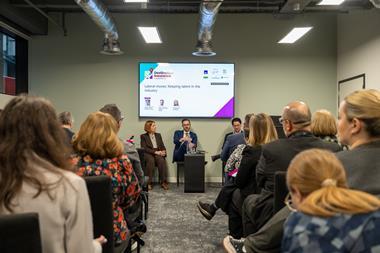Shirley Beglinger, chair of the upcoming Insurance Times Forum: Commercial Lines, Decoding a Competitive Future, outlines some of the questions that will be asked – and answered – at this unique industry event.
So you thought insurance was boring, did you? You got into it for the quiet life, right? Well, wrong, actually.
Remember how you used to buy your insurance? You wandered down to your local broker, maybe took him out for a pint while he filled out the questionnaire and told you where to sign. A few days later, he’d come back and tell you which offer he thought was best for you. You generally accepted his expert recommendation and wrote a cheque for the required amount. After a few weeks or months, your insurance certificates would arrive in the post, often embossed with names like Commercial Union or Independent Insurance Co.
If you bought commercial lines insurance, the procedure was pretty much the same except that you had several brokers filling out forms for you – and they bought you lunch. Afterwards they would trot back to the office and translate your information into a slip, which was strolled around the market until the risk was placed. Your policy would generally show up shortly before the next renewal was due.
Now think about how it’s done today. Not a single step of that process is unchanged. You buy your personal insurance online and save both the brokerage and the price of a pint.
Commercial insurance is a headache to place because every time you turn around, some new risk has emerged and everyone’s scrambling to react. Delivering the 2012 Olympics on a brownfield site extensively visited by the Luftwaffe during the second world war is just one example of emerging insurance challenges. Major projects such as Crossrail are another.
Then they’ve invented this thing called good corporate governance, which apparently requires that you put your programme out to broker-tender every three or four years. When that happens, you discover that the holding broker has kept all the records on paper and everything needs to be laboriously scanned and copied. The perfectly good reason for this apparent idiocy is that many commercial lines underwriters in London prefer to handle a paper file and will simply ignore electronic submissions. So for decades the industry has stubbornly refused to embrace technology.
Well, now technology is embracing us. There are younger, more technologically savvy underwriters coming into the business who are perfectly happy to sit in Bermuda or Zurich and underwrite electronically.
“There are younger underwriters coming into the business who are perfectly happy to sit in Bermuda or Zurich and underwrite electronically.
Shirley Beglinger
The submission gets stored in a data warehouse, policy forms come off an intranet and are sent to the broker’s email inbox, claims are handled online and payments are processed in India, on keyboards made in China. In short, insurance is being dragged into the new technological world and the file-laden broker is trudging after the dinosaurs into the past.
Meanwhile, technology is also changing the way underwriters “manufacture” and price insurance. In the old days, it was the pre-lunch price minus 10%, with details of coverage to be sorted in the distant future. Now computer-based actuarial rating tools take into account such items as industry loss experience, average period of claims settlement, anticipated administration expenses, cost of capital and even aggregate capacity commitment to a single industry.
So both the distribution and the delivery of insurance are changing beyond recognition.
Up in the boardroom, management faces even more complex challenges. Solvency II is the new European directive that tells us how much capital we need to underpin our business. It’s one of the the first pieces of supranational legislation ever experienced by our industry. Even though the FSA’s Individual Capital Adequacy Standards (ICAS) regime has already given us a flavour of how it will work, many of us regard Solvency II with a mix of delight and concern – the first of anything is always a bit of a rollercoaster.
Thanks to the actuaries and their computer models, we now know the hefty cost of capital. So it’s not particularly welcome to have EU rules laid down that seem to suggest we will need much more of it. Capital comes from shareholders and many insurers are now receiving unwelcome attention from “activist” shareholders. Activist shareholders are those who leave no doubt in management minds that they require a healthy return on their investment. So insurers are constantly prowling for new ways to increase the top line, shrink the middle line and expand the bottom line. At the same time, shareholders don’t want us taking any foolish risks with their capital. Thus we turn to reinsurance, or reinsurance in combination with securitisation.
Many of us speak glibly of catastrophe bonds and sidecars, special purpose vehicles (SPVs) and parametric triggers, but have we really thought about how they work? We understand that an SPV is set up, which sells, say, catastrophe bonds. Investors buy the bonds and the SPV invests their money – often in gilts or T-bills or the like. If the wind doesn’t blow and the earthquake doesn’t strike, the investor gets his money back at the end of the period, together with a sizeable coupon – more than he would have received from a “normal” bond investment. If the wind and the earth don’t co-operate, the investor kisses his money goodbye.
But the thing with a parametric trigger catastrophe bond is that it takes indemnity out of the contract. The bond sponsor (the company in whose favour the SPV was set up) does not need to prove that it has suffered a loss. Nor does it have to wait for payment, because the SPV already holds investors’ money. All it needs is for one of the parametric modelling agencies to produce appropriate statistics to indicate that the bond has been triggered.
“Both the distribution and the delivery of insurance are changing beyond recognition.
Shirley Beglinger
But what if the premiums achieved by underwriters at the front end of the business aren’t enough to pay for the bond coupon? If the bond trigger is substantially different from the sponsor’s underlying portfolio (for example, Earthquake Israel but not Greece), will the bond still count for ICAS/Solvency II capital calculation purposes? If the bond counts in the capital calculation, does it count as debt or as equity? Or as a hybrid something-or-other?
Finally, if a catastrophe bond – or even an indemnity bond – is as good as reinsurance, what does that mean for reinsurers?
Why stop at reinsurance? If bond issue is theoretically possible for any player in the insurance value chain, it must surely also be possible for a broker. Why should a broker take business to an insurer when he could theoretically take it straight to the capital markets? What’s to stop a
company like Towergate from doing exactly that? We know that a number of its major carriers are pressing for lower commissions. They all admit that Towergate portfolios produce pretty much exactly the loss ratios that Towergate predicts, but they’ve concluded the price exacted by Towergate is too high. What stops a maverick like Peter Cullum from calling their bluff?
The quiet life, this ain’t. Why not attend the Insurance Times forum at the Hilton Tower Bridge on 13 October?
We’ll be looking for answers to some of those questions. And who knows, maybe we’ll even find inspiration in the brave new world of insurance.
The Insurance Times Forum: Commerical Lines, 13 October
Insurance Times has responded to market demand by launching its first Insurance Times Forum: Commercial Lines, Decoding a Competitive Future. It will be held on 13 October at the Hilton Tower Bridge in London.
Designed to appeal to senior executives in the general insurance market – whether practitioners, brokers or advisers – the Insurance Times Forum will bring together a group of experts to discuss the critical issues facing the industry. Join industry leaders for insightful
discussions and our exclusive live debate between two industry heavyweights: Peter Cullum, executive chairman of Towergate, and Barry Smith, chief executive of Fortis.
The Insurance Times Forum will afford a unique opportunity to network among industry peers both on the day and also leading up to the event. Register today and you can start participating right away. Our exclusive Members Zone will allow you to arrange meetings, check who else will be attending and post your questions in advance for our speakers to respond to at the event.
Hosted by comedian and actor Tom Allen, 34 Gold, 23 Silver and 22 Bronze awards were handed out across an amazing 34 categories recognising brilliance and innovation right across the breadth of UK general insurance.












































